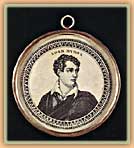 |

For a moment, Liberty,
Let the war, the bloodshed sleep;
Hither come and silently
Over Byron's body weep.
Dionysios Solomos, Ode on the Death of Lord Byron (first verse)
This poem honours the poet and the liberal revolutionary Lord
George Gordon Noel Byron who died at Missolonghi. Lord Byron or 'Mylord'
as he was known among the Greeks, had fought in the rebellious areas and particularly in Missolonghi from December 1823 until 7 April 1824, when he died. His death was acknowledged by the Greek revolutionaries as a
significant blight upon the course of the struggle. His prestige
and his role as a representative of the philhellenic London Committee in a
critical time for the course of the Greek cause contributed to this public feeling.
Byron was one of the most important lyric poets of the first decades of the 19th century. His aristocratic descent did not prevent him from becoming one of the most dynamic liberals in a period when autocracy was re-established on the European continent (Restoration). From 1816 until 1823
he settled in several Italian cities. There he was associated with revolutionaries and more actively with the movement of the carbonari.
The repression of the carbonari in 1823 obliged him to abandon the Italian peninsula. His interest in the Greek struggle then became more active. That year, with the rise to power in Briatin of the liberals of George Canning and the consequent change of the British position toward the Greek cause favoured the development of the philhellenic movement in this country. Thus, when Byron seemed to be deciding on his coming to the rebellious regions he accepted an invitation from the philhellenic committee of London to cooperate and a little later to undertake, as a representative of the committee, the matter of the loan granted to the
Greek Revolutionary Administration.
Leaving Italy he headed for the British-ruled Ionian Islands (Cephalonia).
During his stay there (July-December 1823) he was informed not only about the struggle for independence which was now completing its third year
but also about the political opposition which was now expressed openly
among the revolutionaries. In fact, he was 'besieged' by adverse factions, which hoped to impose themselves on the organs of the Greek Revolutionary Administration by taking advantage of his prestige and of the loan.
At the end of 1823 the opposing sides were preparing for the armed conflict that was about to erupt. After Cephalonia, Byron did not go to
the Peloponnese as initially planned but to Missolonghi, an important city as far as the war was concerned where Alexandros Mavrokordatos again took action. Byron reached Missolonghi on Christmas Eve 1823 and stayed there until 7 April 1824. During his sojourn his main concern was the reinforcement of the town's fortifications and the constitution of an artillery force, for which he undertook the payment of the armed Souliotes.
|
 |